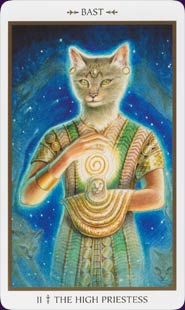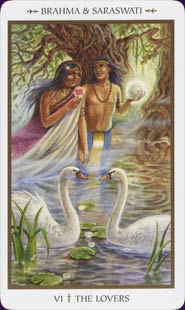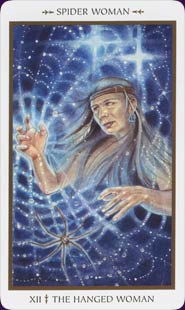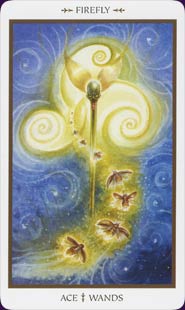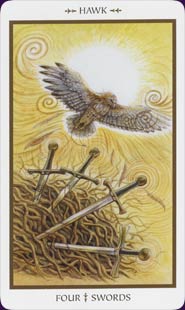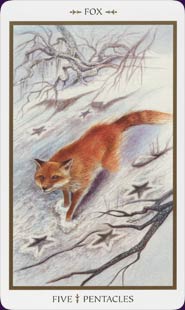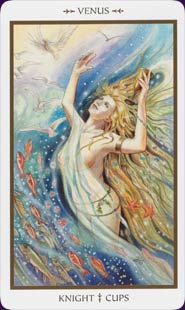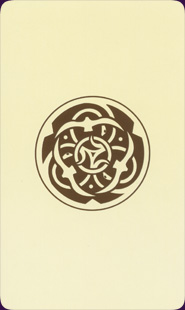Animals Divine Tarot Deck Review
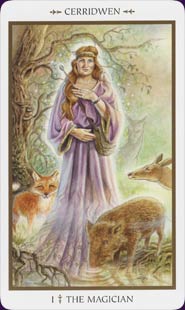
The Animals Divine Tarot has been entirely created by Lisa Hunt, artist of the Shapeshifter and Celtic Dragon Tarot decks. The major arcana and court cards depict watercolour images of animal gods and goddesses, while the suit cards are associated with animals, birds, reptiles and insects of the water, air, earth and fire.
Deck Type: Tarot Deck Cards: 78
Creators: Lisa Hunt
Publisher: Llewellyn 2005
Retailers
See Price at Amazon.comSee Price at Amazon.co.uk
See Price at Amazon.ca
Animals Divine Tarot Review by Bonnie Cehovet
Suits: Wands, Cups, Swords, Pentacles Court cards: Page, Knight, Queen, King.
Major Arcana: Traditional titles, with the exception of: High Priest (Hierophant), The Wheel (Wheel of Fortune), Hanged Woman (Hanged Man), Challenge (The Devil).
The Animals Divine Tarot and companion book come packaged in a beautiful yellow-toned box, with the cover opening from the side for easy access. There is a black organdy bag included to act as a home for the cards. The deck is a traditional 78 cards, with two additional cards that carry the templates for the Animal Journey Spread and the Animal Wheel Spread.
The cards themselves are approximately 2 3/4" by 4 5/8", on high quality, glossy cardstock. The backs are a medium yellow, featuring a dark gold mandala within a dark gold circle in the middle of the card. it would not be possible to tell whether the card had been drawn upright or reversed.
The face of the cards show a white border, followed by an inner black border around the scenes themselves. At the top of the card, in black lettering, is the name of the God, Goddess, or animal represented on the card. At the bottom of the card, in black lettering, is the card number (in Roman numerals) and title for the Major Arcana; the card number (written out) and the suit for the Pips (numbered cards); the title and suit for the Court Cards.
The art is a combination of fantasy and reality, drawing from myth and legend. The colors are subdued, with heavy use of greens, blues, yellows and grays. They have a very flowing nature, and carry a great deal of symbolism that may not at first be apparent.
One of my favorite cards in the deck is the Fool, which carries the energy of the Coyote (the Trickster, in Native American lore). Coyote walks a rocky path strewn with entwined roots. The rocks in his path, rather than acting as obstacles, serve to ground him. The six birds flying overhead indicate change and impermanence. Rather than the "soft" Fool that we are familiar with, this Fool carries an edge that makes us wary.
The theme of birds also shows in the Four of Swords. Here we find four swords, standing upright. Above them flies a Hawk, with the sun shining brightly behind him. Around the Hawk's wings we see spirals, representing renewed life. In his talons the Hawk carries a crystal necklace, representing his vision and sense of awareness.
In Animals Divine the Hanged Man has become the Hanged Woman. She is Spider Woman, from Native American lore. Spiderwoman faces forward, reaching out to the spider web (representing the web of live) in front of her. The feather in her hair signifies her ability to expose the truth - a truth that we sometimes do not wish to acknowledge.
The Nine of Pentacles is represented by the Bear. Pictured is a large bear, walking towards us on all four feet. He is walking through a tunnel of spiraling energy representing the four elements - Fire, Water, Air, and Earth. The Bear is a symbol of protection, according to Hunt, but it also has a strong shamanistic and healing connection in Native American mythology.
The Queen of Swords is represented by the Greek Goddess Athena. We see a full moon behind her, with an owl, representing wisdom, perched on a limb over her right shoulder. The tree roots are there to ground us, and the very visible snake that appears to be coming down from her left arm speaks of transformation - of leaving behind what no longer serves us to make room for the new.
I am absolutely fascinated by the Wheel (Wheel of Fortune) in this deck! True to its nature, it carries the energy of "all animals". The wheel is turning, and change is coming. Pictured here is a virtual vortex of animals, with the elements being represented by their individual colors. Birds and butterflies are in the air, and from the water come the aquatic creatures. Animals are our teachers and guides (and also our protectors). By watching how they live their lives, we will receive messages on how to best live our lives.
In her foreword, Waldherr addresses some of the themes that she sees in the Animals Divine Tarot. A predominate theme is that of integrating our lives with those of the animal kingdom, in a peaceful manner. Waldherr also notes that this deck can serve to help elevate humanities collective consciousness. She notes how the Celtic Dragon and Shapeshifter decks were in many ways necessary precursors to Animals Divine.
I am very attracted to this deck, and learn something new every time that I use it. If you are interested in mythology, in connections with the natural world, or in deepening your connections with your animal guides and mentors, then this is an excellent deck for you.
© Bonnie Cehovet
Animals Divine Tarot Review by Kate Hill
"It is my goal to help inspire you to look at animals in a different light by gazing upon the art in Animals Divine and seeing the variety of ways animals can be portrayed, rendered and celebrated. And in doing so, perhaps this will enable you to see yourself in new and refreshing ways. Animals have something to tell us and the more we open ourselves up to their divine essence, the more we can learn to live more fully and passionately in the moment." – Lisa Hunt
The Animals Divine Tarot is entirely the work of Lisa Hunt, who previously collaborated with D.J. Conway and created the art for the Shapeshifter Tarot and Celtic Dragon Tarot. For this deck, Lisa spent many hours researching, observing and sketching animals of all kinds in preparation, and selected the animals with care to match them to the relevant Tarot cards.
The seventy-eight cards were created in watercolour art and are all fully illustrated. They have a mystical feel, particularly in the major arcana. The majors and court cards are each linked with an 'animal deity', a god or goddess personified by or associated with a particular animal (or animals). The Fool is the Coyote (the Trickster), and the Tower is linked with Thunderbirds, while the remainder feature human-featured or human-figures deities from many different cultures and nationalities. Some are linked with more than one animal, like Hera (the Empress) and the cow and peacock, or Freya (the Chariot) and the golden boar and lynx. The Wheel is a rather lovely card with dozens of animals from all environments moving in an anti-clockwise direction.
The suits of the minor arcana have standard elemental attributions and are: Swords/Air, represented by avian creatures; Wands/Fire represented by reptiles, lizards and insects; Pentacles/Earth, featuring mammals; and Cups/Water illustrated by aquatic animals (both cold and warm blooded). The numbered cards tend more to realism than the dream-like majors or courts, but are lovely nonetheless.
The cards are rather stunning. I liked Death (Sedna), the Knight of Cups (Venus), the Ten of Cups (Whale), Ace of Wands (Firefly), and Ten of Pentacles (Rabbit) the most. Also noteworthy were the Moon card, which shows Odin and a wolf in a desolate landscape lit by an enormous full moon, and the Eight of Cups, which is (of course) an octopus with a cup in each tentacle. The only slightly jarring card for me personally was Gaia on the World card, who, with her heavy-lidded eyes, looked like she’d had a really long, hard night.
All cards are titled in English; the base is printed with the card name and the top with the name of the deity or animal. The major arcana are mostly conventionally titled, except for the Hierophant which has become the High Priest; the Hanged Man, now the Hanged Woman; The Wheel of Fortune, shortened to the Wheel; and The Devil, which is softened to Challenge. The court cards are slightly reordered, keeping their standard meanings but with the Queen as the head of the suit, followed by the King, Knight and Page.
In the hand, the Animals Divine cards are very pleasant to hold, shuffle and use. They are slightly glossy but not overly laminated, without being sticky or so slippery they slide off flat surfaces of their own accord. The backs have a reversible Celtic knot-work design in dark gold on a cream background. There are also two extra cards, to bring the total to eighty, and feature two original spreads: the five-card Animal Journey Spread and the seven-card Animal Wheel Spread.
The Animals Divine Tarot is a beautiful, thoughtful and original deck for divination, meditation and dream-work. While it is perhaps not the best for beginners given the changes made to standard symbolism, I’d recommend the set for anyone who enjoys animal-related decks.
Animals Divine Tarot Review by starsongs
Animals Divine Tarot is a gorgeous deck that follows Rider-Waite structure and incorporates original symbolism. Artist Lisa Hunt uses well-chosen myths, and gods and goddesses from many cultures to breathe new life into the major arcana and court cards. Animals, birds, insects and a variety of sea life prowl, swim, prance, meander, climb, flutter and fly through the minor arcana. Truly this is a deck in motion, mirroring the constant changes and cycles of the earth and all of her life forms.
The art is exceptional and the imagery powerful and evocative. When first looking through the deck, I could not put the cards down. Each one beckons you to enter and once drawn in you are transported to a magical place where the spoken or written word is extraneous and meaningless. Each time there is something new to experience.
I found myself smiling and nodding in recognition of some of the visual interpretations, whilst others were a bit more difficult to grasp at first. Further pondering upon those more difficult to grasp has proven to be very rewarding. The animals are wonderful teachers. I am delighted by the new understandings that Lisa Hunts fresh use of symbols has facilitated.
The accompanying book is well done and fairly detailed and includes some writing about each card, two spreads especially designed for the deck, and thoughts on meditation and connecting with the images. I haven't used either of the spreads, but have used the deck in a few readings for others and the insights shared through the imagery have proven to be relevant and helpful.
The cards themselves come alive beyond the book to lend new insights and imagery to old themes. The Empress represented by Hera, languishes comfortably upon a rock, bare feet grazing the grass. A cow stands behind her. A peacock is to her left (the right side of the card). Only the body and head of the peacock are visible; the tail is hidden. In the forefront and all around the peacock colorful flowers bloom. This seems to suggest that the Empress is highly creative, but uses her creativity to nurture and beautify the earth. Instead of parading it around for show and solely personal gain (peacocks tail) the colorful flowers embody instead the fruit of her creative endeavors.
I especially love Lisa's choices for the court cards; White Buffalo Calf Woman, Poseidon, NaNa Buluku, Ahau Kin and Quetzalcoatl to name a few. These mythic figures capture an archetypal energy that offers another layer of interpretation and meaning; perhaps a more pure one.
Another choice I find particularly meaningful for humanity today is her use of Sedna for the Death key. Other favorite majors include Tara as Strength, Thunderbirds as The Tower, and Xochiquetzal as Temperance. Favorite minor arcana animals include Tiger as the Three of Pentacles, Firefly as the Ace of Wands, Whale as the Ten of Cups, Crow as the Nine of Swords and Alligator as the Five of Cups. Altogether the animals, myths, and legends weave a magical tapestry of wisdom that speaks to the Soul.
Animals Divine may not be the best choice for beginners interested in learning the traditional symbols. It is an excellent deck for anyone wishing to read intuitively, for those desiring a fresh new perspective, for animal and nature lovers, and for those just wanting a feast for the eyes. After watching the progress of and eagerly anticipating this decks release, I was delighted to find it was even lovelier than I had imagined it would be. Animals Divine has already become a favorite and Im certain it will withstand the test of time.
Animals Divine Tarot Review by Chloe McCracken
As soon as I read about this deck, I loved the idea. From the back of the book: "They appear to us as guides, totems, familiars... glimpsed on quiet hikes, in vivid dreams, or even on your windowsill, the wild world of animals is a vast source of spiritual wisdom and primal power. The potent symbols and intricate images of the Animals Divine Tarot help you connect with that power through divination, meditation, and dream work."
For those who have seen images from any of Lisa Hunt's decks, the Shapeshifter Tarot, the Celtic Dragon Tarot, or the most recent, the Fantastical Creatures Tarot, it will come as no surprise that the deck is full of beautiful, nature-based imagery, with plenty of celtic and other traditional symbolism thrown in. And this is certainly the strongest point of the deck, the animals are really life-like, in context, and lovingly portrayed.
Why do an animal-based deck? Lisa Hunt discusses the importance of animals in many mythological and spiritual systems throughout the world and throughout history, mentions the link between animals and our own more primitive, animalistic and unconscious aspects, suggests animals are also a source of inspiration and creativity, and highlights the links which we still regularly form with animals for well-being and companionship. She writes: "It is my goal to help inspire you to look at animals in a different light by gazing upon the art in Animals Divine and seeing the variety of ways animals can be portrayed, rendered and celebrated. And in doing so, perhaps this will enable you to see yourself in new and refreshing ways. Animals have something to tell us and the more we open ourselves up to their divine essence, the more we can learn to live more fully and passionately in the moment." Noble sentiments, indeed.
So, what of the structure of the Animals Divine Tarot? The Major Arcana generally follow traditional RWS numbers and names, though X (The Wheel of Fortune) is simplified to just The Wheel, XII (The Hanged Man) becomes the Hanged Woman, and XV (The Devil) becomes Challenge. Each Major is also attributed to a deity from around the world, and there is generally a strong link to traditional RWS meanings for the cards.
The Minors are made up of the traditional suits of Wands, Cups, Swords and Pentacles, and these are linked to the most common elemental attributes, for the most part. So, Cups feature water-based animals (though the Three is a swimming polar bear). Swords are air-based, mainly birds apart from the Five, which shows bats. Pentacles show a variety of earth-based mammals, while Wands are the most eclectic, featuring six insects, an amphibian and three reptiles.
As for the Court Cards, while following the traditional names of King, Queen, Knight and Page, each one represents a deity. The Knights contain three goddesses and a god, while the Pages have three gods and a goddess. And here we hit on one of my issues with this deck. I can understand wanting to bring some balance to gender stereotypes, and fully accept that Ms Hunt puts the Court Cards in the order of Queen, King, Knight and Page. In this sense, I can see the logic of more of the Knights being female than male, though then why not just make all the Knights women? However, Hanuman is the Page of Pentacles, and is a monkey so I'm not sure whether "he" really counts for gender balance on the male side. Furthermore, I'd have thought Hanuman a more appropriate Knight - he charges off trying to rescue his friend's wife, not letting anything stop him, which doesn't strike me as a good expression of Page of Pentacles energy, though I guess his loyalty and inquisitiveness do fit better. And I don't feel that female deities necessarily best represent the generally dynamic energies of the Knights. We find an aboriginal creation goddess (Yhi) as the Knight of Wands, which certainly doesn't fulfill my ideas of what this card represents. Perhaps I'm getting too stuck in traditional interpretations of the cards, but I feel that you should either follow tradition, or clearly walk your own path, but while these Court Cards claim to do the former, I'm unconvinced. The images don't clearly express the traditional concepts of the cards, and the deities often seem rather a reach, too.
This issue becomes critical, in my eyes, in the Major Arcana. The traditional Majors are very well-balanced in terms of gender, surprisingly so given their medieval roots. However, in the hands of Lisa Hunt we end up with three purely animal Majors, six "male" Majors (though two of these have animal heads), one couple (the Lovers, duh!), and twelve goddesses (admittedly one also has an animal head). So, twice as many obviously female images as male ones. Where is the justification for this in animal pantheons, or in the animal kingdom? There isn't even a justification in Lisa Hunt's own writing and descriptions. Now, as a woman and avid Goddess/empowered feminine deck collector I'm certainly not against bringing the female into focus. I just don't see the rationale here.
Even accepting a female imbalance, there are some choices which seem distinctly peculiar. For example, the Animals Divine Moon isn't a female deity!! Instead we see Odin, accompanied by a wolf. The explanation? He followed his intuition and drove warriors berserk. The fact that the text tells the story of Odin hanging from Yggdrasil, the world tree, begs the question: why not have Odin as the Hanged Man, and have a female deity for the Moon? There are plenty of goddesses that would fit the bill!
I don't want to imply with this little rant that I don't like the deck. For me, the best part of the Animals Divine Tarot is precisely the animals. So, my favourite element is the pip cards. Most of the images on the pips are, at first glance, unrelated to traditional meanings of any school. There are a few exceptions, for example the Six of Cups shows carp heading up-stream to their spawning grounds. The Five of Pentacles shows a fox making it's way through a snowy landscape, with the shadow of some birds overhead (vultures?) Two otters swim together in the Two of Cups, while a vulture sits in a tree pierced by Three Swords in the card of that name. Somewhat more subtly, the quick, industrious ant is shown on the Eight of Wands, while the Six of Wands shows a caterpillar successfully transforming into a bright and beautiful butterfly.
However, when you read the companion book the author does actually try to link each pip to quite traditional RWS meanings. This isn't obvious in the images, and isn't always entirely convincing, but it does mean that the deck could be used for general readings. While it will never be a "beginner's" deck, if someone is drawn to animals they could certainly use the deck for readings of any kind. And the fact that the images are so apparently non-traditional allows for some out-of-the-box thinking, while still being usable for very normative understandings.
In any case, the imagery is always beautiful and really draws you in. I've had some truly moving experiences meditating on these cards, connecting with the earth's creatures both great and small. This is definitely one of the greatest strengths of the deck, the balance it achieves in looking at different kinds of animal, and finding their beauty, strength, creativity, playfulness, majesty, and subtlety. I love that we can commune through this deck with everything from a lady bug (Four of Wands) to a whale (Ten of Cups), from a duckling (Ace of Swords) to a panda (Two of Pentacles). The companion book encourages us to think about how it would be to live life as these various creatures, and thus to tap into a completely new perspective. For this alone I would applaud the deck, and recommend it to anyone who wants to get more in touch with the amazing beings we share the planet with.
Complete Details of Animals Divine Tarot
Creators: Lisa HuntPublisher: Llewellyn 2005
Deck Type: Tarot Deck
Cards: 78
Major Arcana: 22
Minor Arcana: 56
Deck Tradition: Rider-Waite-Smith
Minor Arcana Style: Unique Scenes With Suit Symbols
Suits: Cups, Swords, Wands, Pentacles
Court Cards: Page, Knight, Queen, King
Major Titles: The Fool, The Magician, The High Priestess, The Empress, The Emperor, The Hierophant, The Lovers, The Chariot, Strength, The Hermit, The Wheel, Justice, The Hanged Woman, Death, Temperance, Challenge, The Tower, The Star, The Moon, The Sun, Judgement, The World
The Fool is 0
Strength is 8
Justice is 11
Card Size: 2.76 x 5.00 in. = 7.00cm x 12.70cm
Card Language: English
Card Back: Reversible
Back Design: Cream with gold central pattern
Companion Material: Companion book of 196 pages is packaged with the cards in the cardboard kit.
Extra Info: Read a review of the book, Animals Divine Companion.
Rating: 18/20 or
Similar Decks to Animals Divine Tarot
Theme: AnimalCreator: Celtic Dragon Tarot, Fairy Tale Lenormand, Fairy Tale Tarot, Fantastical Creatures Tarot, Ghosts and Spirits Tarot, Shapeshifter Tarot, Winged Enchantment Oracle by Lisa Hunt
< Previous Deck · Back to Top · Next Deck >
Home > Tarot Reviews > Animals Divine Tarot Review

